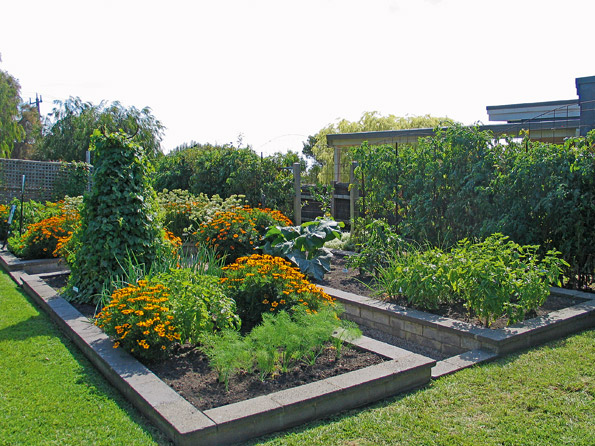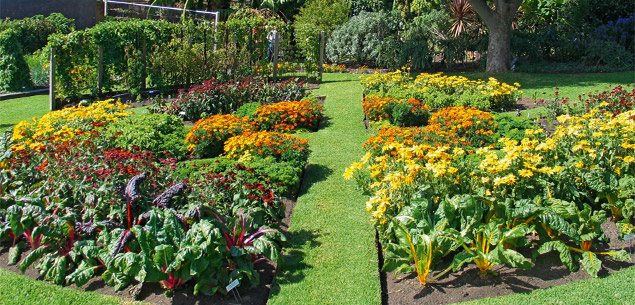When I was a child, my parents had a vegetable garden. It was a big, rectangular plot planted in straight rows. Because our section was sloping, so was the vegetable garden, which was probably the cause of many a sore back. And, in common with most New Zealand properties at the time, it was
hidden away like a guilty secret with the compost bins, rubbish cans and clothesline in a part of the section visitors couldn’t see.
This strictly utilitarian model evidently evolved during the 19th century as people moved from rural to urban living.
Everyone knew that tools and machines worked best in straight lines, so this was translated into the backyard vege patch and it has stuck.
Ironically, the backyard can be the worst place to grow vegetables. It’s often on the south side, which doesn’t get as much sun. And because it’s hidden, you’re less likely to pass by several times a day, which means weeds don’t get pulled out, maintenance work isn’t done and food isn’t harvested as often as it should be.
So, the simple solution is move it to the front and make it attractive enough to be a part octagonal, semi-circular, or circular with intersecting
paths. If you have the space, you could create a series of smaller plots linked by fruit trees or herb-lined paths.
Ideally, beds should be raised – not just because it’s fashionable, but because it provides better drainage for plants, and the soil heats up faster, adding days to the growing season. It also means you can fill beds with the perfect soil mix, rather than digging over what’s already there. And yes, it does look better.

Once the area is defined and the beds created, treat the space as you would a decorative garden. If you have several beds, you’ll need paths between them, and paving, stone or shell paths will add to the aesthetics and keep your feet dry.
You can also enhance the environment by adding trees to the mix. A border of evergreen fruit ones will provide more food, shelter your vegetables
and give the landscape some height. If that’s not practical, a trellis or fence behind the garden can provide a place to grow climbers such as grapes or miniature kiwifruit.
Use it as a gallery for a quirky wall-hanging to add visual impact to the space. And don’t forget to add somewhere to sit. There are few greater pleasures than sitting down with a cool glass of something lovely to admire the fruits and vegetables of your labours.
POTS OF CHARM
If you think your vegetable patch lacks charm, introduce a few plants in containers. It adds another dimension to the garden, and is especially good for growing invasive herbs such as mint.

SIMPLE STEPS TO COMPOST CULTIVATION
Compost is possibly the least romantic of all garden components, and one that causes new gardeners a heap (excuse the pun) of issues.
But, happily, making it doesn’t have to be technical, complicated or even particularly scientific. Everyone has a method – simple or otherwise – and which one you use depends on how much time you have, and how much compost you want.
I hanker after one of those big plastic bins with a handle. Chuck all the garden rubbish and household scraps in, wind the handle whenever you walk
past and, after several weeks, you have compost. Of course, the issue is that you need at least two of them – and that would pay for a load of plants.
A cheaper and fairly easy way is to put lawn clippings, leaves and other garden waste into a big, black, plastic garbage bag, seal it, and put in a warm spot. Turn it over a couple of times a week and open after three months to check the contents. With luck, you’ll have nice garden compost. If it hasn’t broken down enough, reseal the bag and leave for a couple more months.
The next step is to purchase a purpose-built compost bin from the hardware store; they cost from $50 to $300. Serious composters buy three or four bins. When the rst one is full and doing its thing, you start the second one, and so on.
By the time the last one is full, the first one is ready to use. Some local councils are now taking sustainability seriously and encouraging people to compost. The Hutt City Council is running composting and sustainable living workshops, and anyone who signs up gets a discount on a bin. I love that.
TAKE A PEW
Add seating overlooking the vegetable garden so you can admire everything you’ve done.

RAISE ‘EM UP
Four raised beds linked by a sunken path make this vegetable garden practical and stylish. Trellising at the back provides somewhere for climbing plants to grow.
ILLICIT PLOTS
There are moves afoot all over the place to liberate the traditional vege patch and bring it, quel horreur, into the spotlight. We’re lucky that in
New Zealand, nobody gets too excited about that. In the United States, you’d be in all sorts of trouble. Over the past few years, since vege gardeners there finally figured out that the front garden was the go for growing food, several gardeners have been punished for their temerity.
In Missouri, a man was ordered to dig up his 55 varieties of fruit and vegetables because they were planted out front, an Oklahoma gardener had
her herbs and vegetables cleared from the front garden by the city authorities, and in Michigan, a mother of six faced a prison term for refusing to take out the raised beds in front of her home as they were deemed non compliant with a city ordinance.
I feel censure by the district council coming on for the fact that my vegetable garden is clearly visible from the road, where it’s sunny, sheltered
and easily tended. But it’s also quite good looking!




